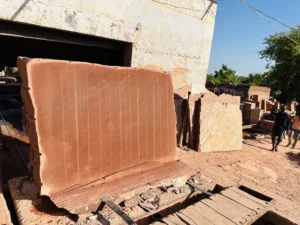Dholpur Red Stone: A Marvel of Indian Architecture
The Dholpur red stone, also known simply as Dholpur stone, is an exquisite natural sandstone, renowned for its rich crimson hue, which has been a cornerstone in Indian architecture for centuries. Mined in the Dholpur district of Rajasthan, India, this stone has contributed to the aesthetic and structural elegance of countless Indian monuments, temples, and palaces, making it an integral part of the country’s architectural heritage.
Historical Significance
The history of Dholpur red stone is as rich and colorful as its appearance. Its use in construction dates back to the Mughal era, when it was extensively used in the making of significant architectural marvels such as the Agra Fort and Fatehpur Sikri. The Mughals, known for their love of beauty and precision, favored the Dholpur red stone for its durability, ease of carving, and, most importantly, its vibrant color that added a unique charm to their constructions.
Physical and Chemical Properties
Dholpur red stone is celebrated not just for its beauty but also for its physical and chemical properties that make it an excellent building material. It is incredibly durable, resistant to weathering and water absorption, which ensures the longevity of structures built with it. Moreover, its ability to withstand harsh weather conditions without losing its color or finish makes it a preferred choice for both indoor and outdoor applications.
Applications in Modern Architecture
In contemporary architecture, Dholpur red stone continues to be favored for a variety of applications including flooring, cladding, and landscaping projects. Architects and designers value the stone for its versatility, allowing it to blend seamlessly with both traditional and modern designs. Its natural texture and color bring warmth and elegance to any space, making it a popular choice for luxury homes, commercial buildings, and public spaces.
Extraction and Environmental Impact
The extraction of Dholpur red stone is a labor-intensive process that has been refined over generations. Sustainable mining practices are increasingly adopted to minimize environmental impact, with efforts focused on reducing waste and ensuring the responsible use of resources. The industry provides employment to thousands of locals, contributing significantly to the economy of the Dholpur region.
Challenges and Conservation
Despite its popularity, the Dholpur red stone industry faces challenges such as over-extraction and the consequent environmental degradation. Efforts are being made by government and non-governmental organizations to promote sustainable mining practices. Moreover, there’s a growing emphasis on the conservation of historical monuments made from Dholpur red stone, ensuring that this heritage is preserved for future generations.
Conclusion
Dholpur red stone is not just a building material but a symbol of India’s rich architectural legacy. Its vibrant hue, durability, and versatility have made it an enduring favorite among architects and builders throughout history. As we move forward, the balance between its extraction and conservation will be crucial in maintaining its legacy and availability for future architectural marvels. The beauty and resilience of Dholpur red stone continue to inspire and influence the design and construction of spaces across India and beyond, cementing its place in the annals of architectural history.

